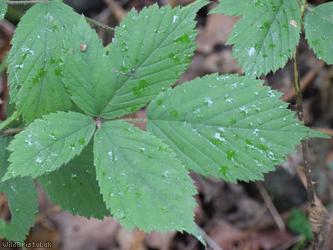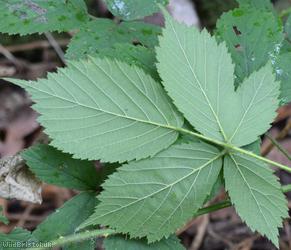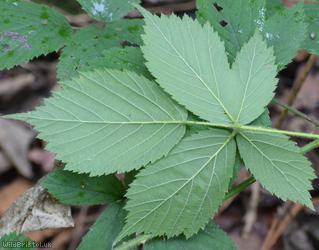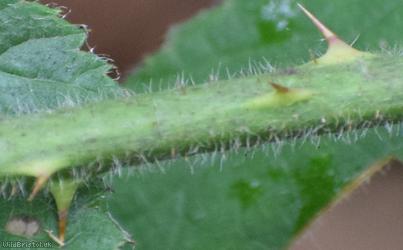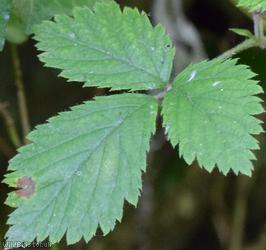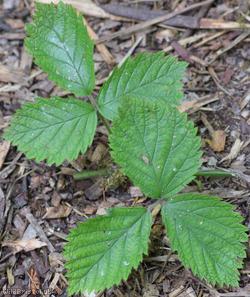Bloxam's Bramble - Rubus bloxamii
Favourite Photos
Species Description
Widespread and scattered mainly along the Western side of England from Exeter and Redding in the South to Burnley just North of Manchester. Habitat includes: woodland. Previously called R. multifidus.
Useful Links:
Workings out:
Series Radulae or Vestiti
Looks unique. Found in woodland. Locally abundant around Badock's Wood. Yellowy-green leaves with deep, mucronate serrations
It matches closely to R. bloxamii which has been recorded in Badock's Wood according to NBN. It also looks like R. conspersus GBIF and shows some similarities to R. flavescens.
I originally thought it could be a hybrid between R. caesius and R. vestitus but it's not.
RUBI of GREAT BRITAIN and IRELAND:
R. Bloxamii Ed. Lees ap. Steele, 1847, Hand. Field Bot. 55; R. pallidus ssp. Bloxamii (Ed. Lees) Sudre, 1908-13, 154, t. 150; R. multifidus Boul. & Malbr. 1873, Assoc. Rub.
Robust (yes), axes hirsute (yes). Stem angled (yes), glaucescent (I think so); prickles yellowish (yes), rather short (not sure - more medium), unequal (yes), patent to sharply declining (yes). Leaflets 5 (-7) (yes but quite a few with 3), coarsely and very compound serrate (yes); terminal leaflet obovate-oblong (yes), acuminate or truncate-cuspidate (yes); base entire (yes). Panicle large (not really), lax (fairly), with a leafy corymbose apex (yes) and distant (yes), long-stalked (fairly), numerous flowered branches (yes); rachis zigzag (yes), densely villous and acicular (I think so but can't tell), prickles weak (sort of - it is thin and 'snapable' at the apical end but broad-based and sturdy at the proximal), slanting (yes). Flowers 1.5-2.5 cm (don't know); sepals greenish grey (yes), leafy-tipped (I think so but can't tell); petals 5-8 (don't know), oblong (don't know), white or pinkish (don't know); styles greenish (don't know). Carpels pilose (I think so but can't tell). I have sometimes seen the sepals clasping about mid August. England, Wales. Well distributed and rather frequent in wooded districts; 2-4, 8-12, 14, 16, 17, 21-23, 33, 34, 36-40, 44, 49, 55, 57, 63, 64, 66, 69. Guernsey. North France, Belgium, Denmark, North Germany, Switzerland, Bavaria.
R. conspersus W. Wats. 1935, Journ. Bot. 23, 255.
Axes mottled (yes) to wholly red. Stem obtuse-angled (yes), slightly furrowed (yes), with tufted hair concealing numerous very short glands (yes); prickles yellowish at first (yes), strong (yes but thin and 'snapable' at apical end), subequal (yes). Leaves yellowish green (yes), digitate (yes), rather large (no), petiole thick (no), flat above (I think so); leaflets 5 (yes but often 3), softly yellowish (yes), pilose to felted as well beneath (yes); terminal leaflet elliptic-obovate (yes), acuminate (yes), base nearly entire (yes). Panicle sub-pyramidal (yes), rather long (yes), dense at the rounded (yes), narrow (yes), leafy top (yes), middle branches long-peduncled (sort of), patent (no); rachis stout (yes), pilose (yes), shortly glandular (don't know), weakly and sparsely armed (don't know). Flowers about 2.5 cm (don't know), incurved (don't know); sepals acicular and gland-dotted (don't know); petals broad elliptic rhomboid (don't know), undulate (don't know), bright pink (don't know); filaments pinkish (don't know), hardly longer that the greenish styles (don't know). Carpals bearded (don't know). Fruit rather large (no they're small), ovoid (no), pleasantly flavoured (don't know, aren't they all?). England, Ireland. Locally frequent; 12-14, 17, 69, H. 39 (Ballymena), Guernsey.
